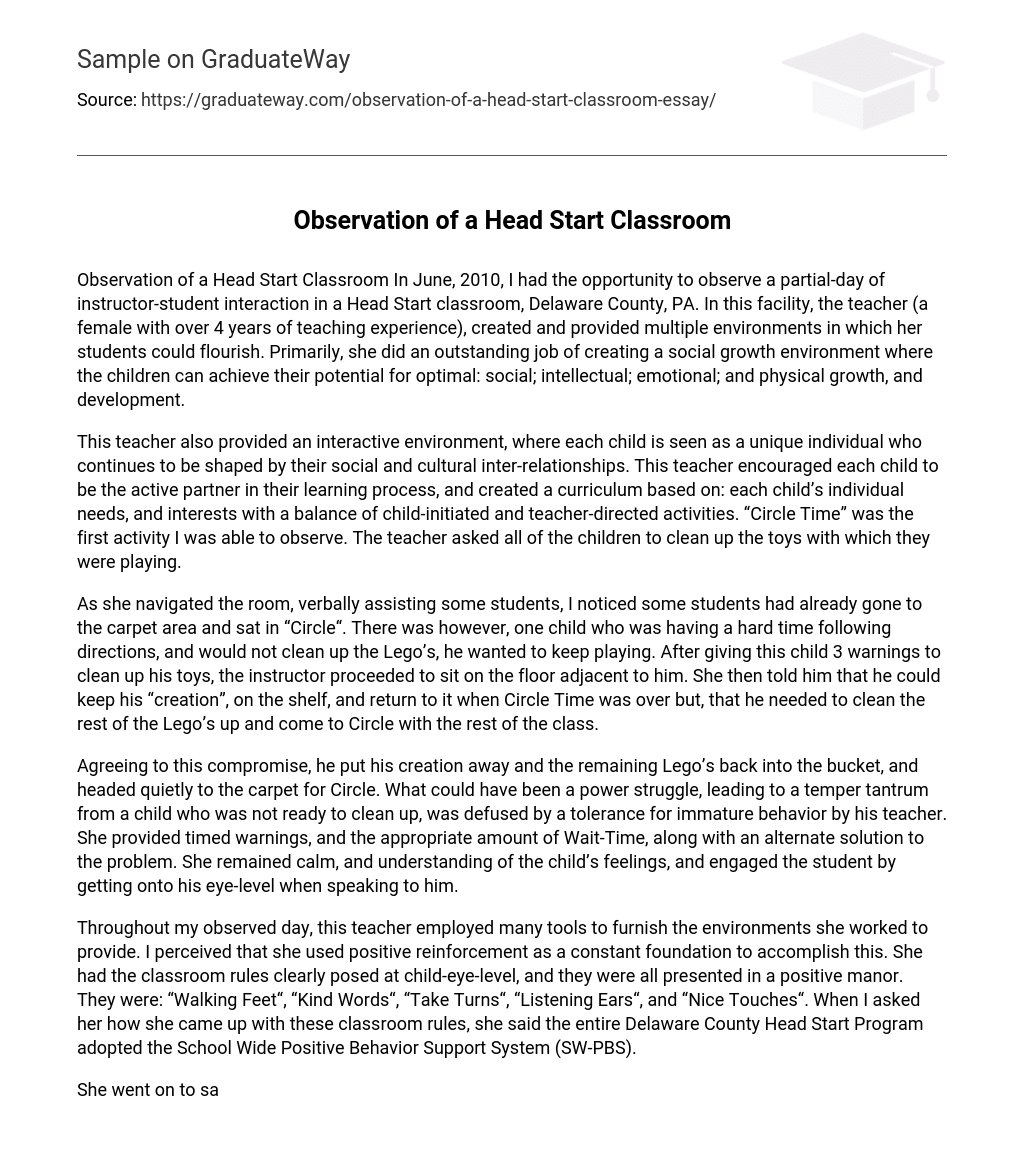Observation of a Head Start Classroom In June, 2010, I had the opportunity to observe a partial-day of instructor-student interaction in a Head Start classroom, Delaware County, PA. In this facility, the teacher (a female with over 4 years of teaching experience), created and provided multiple environments in which her students could flourish. Primarily, she did an outstanding job of creating a social growth environment where the children can achieve their potential for optimal: social; intellectual; emotional; and physical growth, and development.
This teacher also provided an interactive environment, where each child is seen as a unique individual who continues to be shaped by their social and cultural inter-relationships. This teacher encouraged each child to be the active partner in their learning process, and created a curriculum based on: each child’s individual needs, and interests with a balance of child-initiated and teacher-directed activities. “Circle Time” was the first activity I was able to observe. The teacher asked all of the children to clean up the toys with which they were playing.
As she navigated the room, verbally assisting some students, I noticed some students had already gone to the carpet area and sat in “Circle“. There was however, one child who was having a hard time following directions, and would not clean up the Lego’s, he wanted to keep playing. After giving this child 3 warnings to clean up his toys, the instructor proceeded to sit on the floor adjacent to him. She then told him that he could keep his “creation”, on the shelf, and return to it when Circle Time was over but, that he needed to clean the rest of the Lego’s up and come to Circle with the rest of the class.
Agreeing to this compromise, he put his creation away and the remaining Lego’s back into the bucket, and headed quietly to the carpet for Circle. What could have been a power struggle, leading to a temper tantrum from a child who was not ready to clean up, was defused by a tolerance for immature behavior by his teacher. She provided timed warnings, and the appropriate amount of Wait-Time, along with an alternate solution to the problem. She remained calm, and understanding of the child’s feelings, and engaged the student by getting onto his eye-level when speaking to him.
Throughout my observed day, this teacher employed many tools to furnish the environments she worked to provide. I perceived that she used positive reinforcement as a constant foundation to accomplish this. She had the classroom rules clearly posed at child-eye-level, and they were all presented in a positive manor. They were: “Walking Feet“, “Kind Words“, “Take Turns“, “Listening Ears“, and “Nice Touches“. When I asked her how she came up with these classroom rules, she said the entire Delaware County Head Start Program adopted the School Wide Positive Behavior Support System (SW-PBS).
She went on to say, SW-PBS has been demonstrated to be a feasible, and valued approach for improving the social climate of schools, and supporting intervention programming for students with high-risk problem behavior. Because it is a school-wide program, all of the classrooms have the same rules. As the teacher circulated around the room, she praised the children who were doing a good job. She thanked children for sitting and looking at books, and she commended children who were taking turns and sharing nicely.
She was clearly modeling desired behavior by speaking clearly and calmly and by keeping a positive demeanor. Along with keeping a positive attitude, she frequently used open-ended questions. I also noticed there were several posters around the room on which were open-ended questions specific to that activity area. The teacher said, she posted them to remind her to use that type of question on a regular basis. In some cases she even used open-ended questions to scaffold the children’s thinking.
Employing Vygotsky’s Scaffolding, to assist, enrich and strengthen even play-time interactions, this instructor found many opportunities for child learning. As a scaffolding activity, the teacher used a “fly swatter” game. She had pictures of large flies each with a letter on its back. After giving each child a fly swatter, she then asked them, one at-a-time, to find a fly with a certain letter on it. They were to go the fly and “swat it! ” During this large group activity, I noticed that some children did not know the letters of the alphabet, whereas others knew every letter. Similarly, ome children knew very few concepts about print (e. g. , alphabet knowledge, directionality of print, concept of word), whereas others knew a great deal. In terms of scaffolding, the task given to the child was at the appropriate level within the child’s Zone of Proximal Development. This made the scaffolding experience successful and it fostered development. My visit was a pleasant experience and I enjoyed watching the children and the instructor learn through out my stay. In my opinion, the key ingredient of a high quality early childhood program is teacher-child interaction.
This Head Start Program instructor has the control to assist the development of a child or delay the development of a child. She used multiple teaching strategies, conflict resolution, positive reinforcement, open-ended questions, and scaffolding to bolster the children’s learning. Her classroom is child-centered and she uses age-appropriate strategies. This classroom environment itself is literacy rich, colorful and inviting. Overall, I observed successful teacher/child interactions that foster growth and learning in both the instructor, and the children, in a productive Head Start Program.





